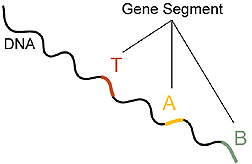
The number of chromosomes in a working cell would be the same as the number of DNA molecules. Also DNA molecules are in pairs, termed homologous (two DNA molecules with the same gene sequence but not necessarily the same genes). One of each pair is furnished by each of the parents. During cell division the DNA molecules of the chromatin twist and coil into short condensed rod shaped structures called chromosomes as indicated by the figure below. The two chromosomes with the same gene sequence are called homologous pairs or homologues. In the figure below homologous chromosomes are of the same length. Note that there is a red and blue long set of chromosomes, red and blue medium set of chromosomes, and red and blue short set of chromosomes. Cells that contain homologous pairs of chromosomes are called diploid as compared to cells that contain only one of each pair being called haploid. We will discuss haploid nuclei in the section describing meiosis. Study behavioral objective 5 and read the pages indicated by G-4. In your notes write out the definition for homologous chromosomes, diploid and haploid.

The figure above represents a cell containing six chromosomes. In this figure homologous chromosomes are of the same length but different color. Also in this figure each chromosome consists of two strands (chromatids). This will be explained later.
9. Does this figure represent a diploid or haploid condition?
- a) haploid
- b) diploid
k
k
The above figure represents two DNA molecules (or chromosomes) showing the same gene segment sequence. This represents one homologous pair of chromosomes. In the next miniunit you will learn that the genes for the same phenotype -T- on each chromosome do not have to be the same. They will be indicated by either an upper case letter or a lower case letter. For example if the gene -T- controls which color of pigments that may be formed in rose petals, the upper case "T" may represent red (dominant) and the lower case "t" may represent white (recessive) pigments.
Therefore, another arrangement of homologous pairs for the figure above may be Tt, Aa, BB.
10. Which of the following do not represent a homologous pair
of chromosomes?
T a
b
a)
-----------------------------------------
-----------------------------------------
t A
B
t A
b
b)
-----------------------------------------
-----------------------------------------
t A
B
T A
b
c)
-----------------------------------------
-----------------------------------------
C F
H
C F
H
d)
-----------------------------------------
-----------------------------------------
c F
h
Press here to check your answer.
k
11. How many chromosomes are present in the cell pictured above?
- a) 3
- b) 6
- c) 12
12. How many homologous pair of chromosomes are in the cell pictured
above?
- a) 3
- b) 6
- c) 12
Answer the following question correctly proceed to the next page.
A cell containing homologous chromosomes is termed:
For information on how to use this page, go to How to Use This Site.Created by the Center for Learning Technologies, Academic Technology Services.
Last modified October 22, 1997.